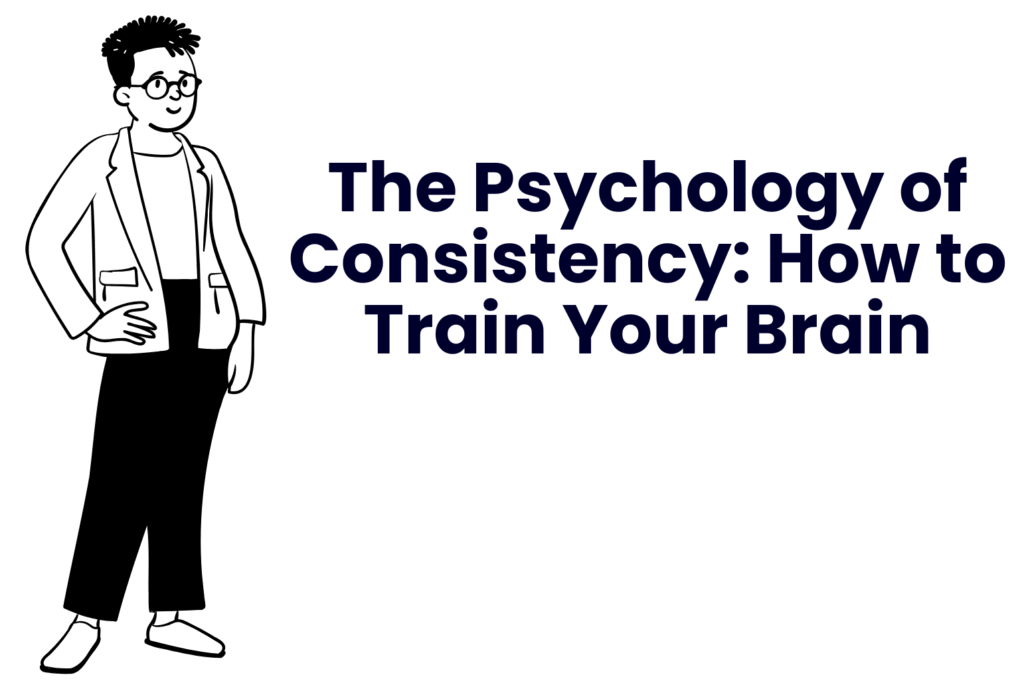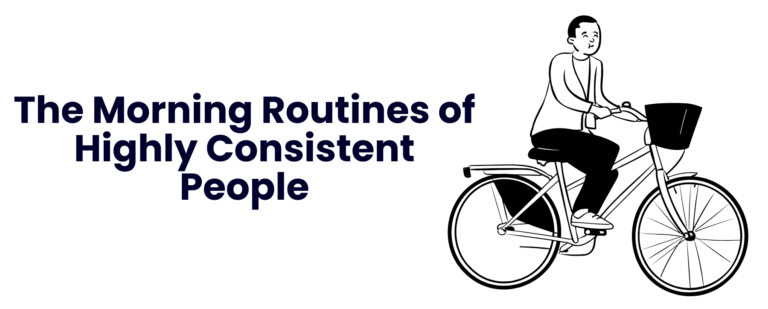The Psychology of Consistency: How to Train Your Brain
Consistency is the secret to building habits that actually stick. The psychology of consistency explains why some people effortlessly maintain consistency while others struggle with basic daily behaviors. Moreover, when you master consistency and learn how to train your brain, you develop the mental foundation for achieving any long-term goal.

This isn’t about willpower or motivation. Instead, it’s about working with your brain’s natural patterns to create automatic consistent behaviors that stick for life.
Why Your Brain Resists Consistency
The Psychology of Comfort Zone Protection
Your brain evolved to conserve energy and avoid unnecessary risks. Consequently, it treats new behaviors as potential threats to your survival. Furthermore, this ancient programming explains why change feels so difficult even when it’s clearly beneficial.
The Comfort Zone Chemistry
When you stick to familiar routines, your brain releases calming neurotransmitters. However, attempting new behaviors triggers stress responses that make you want to return to old patterns. Therefore, understanding this chemical reaction helps you prepare for and overcome resistance.
The Psychology of Instant Gratification
Modern life floods your brain with instant gratification. Additionally, social media, junk food, and entertainment provide immediate dopamine hits. Consequently, long-term goals that require delayed gratification feel less appealing to your reward-seeking brain.
The Psychology Behind Consistent Behavior
Understanding the Psychology of Habit Formation
Every time you repeat a behavior, you strengthen specific neural connections. Moreover, these pathways become like mental highways that make the behavior easier and more automatic over time. Furthermore, neuroscience research shows that consistent repetition literally rewires your brain structure.
The Habit Loop in Your Brain
Your brain processes habits through a three-step loop:
1. Cue Recognition: Environmental triggers that signal it’s time for the behaviour
2. Routine Execution: The actual behaviour itself
3. Reward Processing: The positive feeling that reinforces the loop
Understanding this loop helps you design consistent habits that work with your brain rather than against it.
The Psychology of Automatic Behavior
Once habits become automatic, they move from your prefrontal cortex (conscious decision-making) to your basal ganglia (automatic processing). Therefore, truly consistent behaviors require almost no mental energy to maintain.
Strategy 1: Train Your Brain for Consistency
Design Irresistible Cues
Your environment should trigger consistent behavior automatically:
- Visual cues: Place workout clothes where you’ll see them first thing
- Time-based cues: Link new habits to existing routines
- Location cues: Designate specific spaces for specific activities
- Social cues: Surround yourself with people who model consistent behavior
Make the Routine Effortless
The easier your habit feels, the more likely you’ll stick with it:
- Reduce friction: Remove obstacles that make the behavior difficult
- Batch similar activities: Group related tasks together
- Use implementation intentions: “When X happens, I will do Y”
- Start smaller: Choose a version you can do even on bad days
Engineer Immediate Rewards
Your brain needs quick positive feedback to reinforce new patterns:
- Internal rewards: Notice how good habits make you feel immediately
- External rewards: Give yourself small treats for consistency
- Social rewards: Share progress with supportive people
- Progress rewards: Track streaks and celebrate milestones
Strategy 2: Build Mental Consistency Muscles
The 2-Minute Rule
Make new habits so small they take less than two minutes to complete. Furthermore, this tricks your brain into thinking the behavior isn’t a big deal. Additionally, tiny habits build momentum that makes expansion natural over time.
The 20-Second Rule
Reduce the activation energy for good habits by 20 seconds. Meanwhile, increase the activation energy for bad habits by 20 seconds. For example, put healthy snacks at eye level and hide junk food behind other items.
The Environment Hack
Change your physical environment to support consistent behavior:
- Remove temptations that derail your progress
- Add visual reminders of your goals and commitments
- Create dedicated spaces for important activities
- Use technology wisely to support rather than distract from your goals
Strategy 3: Develop Consistency Through Identity
Shift From Goals to Consistent Identity
Instead of “wanting to exercise more,” become “someone who exercises regularly.” Moreover, this identity shift makes consistent behavior feel natural rather than forced. Additionally, every action becomes a vote for the type of person you want to be.
The Psychology of Consistency in Daily Life
The words you use shape how you see yourself:
- Instead of: “I’m trying to eat healthy”
- Say: “I eat healthy foods”
- Instead of: “I want to be more organized”
- Say: “I’m an organized person”
Collect Identity Evidence
Notice and acknowledge every time you act consistently with your desired identity. Furthermore, this builds confidence and reinforces the neural pathways associated with your new self-image.
Strategy 4: Master the Psychology of Consistency
Expect and Plan for Resistance
Your brain will resist new patterns for approximately 66 days. However, knowing this helps you push through difficult periods without giving up. Additionally, prepare specific strategies for handling resistance when it appears.
Use the 10-Minute Commitment
When motivation is low, commit to just 10 minutes of your consistent behavior. Often, starting is the hardest part, and momentum carries you beyond the minimum. Moreover, even if you only do 10 minutes, you maintain the neural pathway.
Practice Mental Rehearsal
Visualize yourself performing your consistent behavior before you actually do it. Additionally, mental rehearsal strengthens the same neural pathways used for actual performance. Furthermore, sports psychology research shows this technique significantly improves real-world performance.
The Compound Effect of Consistency Training
Week 1-2: Building the Foundation
During the first two weeks, focus entirely on showing up. Additionally, don’t worry about perfect performance or amazing results. Instead, concentrate on creating the neural pathway through repetition.
Week 3-8: Strengthening the Pattern
The behavior starts feeling more natural, though it still requires conscious effort. Moreover, you begin noticing positive changes in related areas of your life. Furthermore, the habit becomes part of your routine rather than an extra task.
Month 3+: Automatic Consistency
The behavior becomes truly automatic and requires minimal mental energy. Additionally, skipping the habit actually feels uncomfortable because your brain expects the routine. Consequently, you’ve successfully rewired your neural programming.
Advanced Psychology of Consistency Techniques
The Psychology of Mental Energy Management
Your brain has limited decision-making energy each day. Therefore, reduce mental load by:
- Making decisions in advance rather than in the moment
- Creating simple rules that eliminate choice paralysis
- Batching similar decisions together
- Automating routine choices whenever possible
The Psychology of Building Consistency Under Pressure
Practice your consistent behaviors under slightly stressful conditions. Additionally, this builds resilience and ensures your habits survive difficult periods. Furthermore, stress inoculation makes normal circumstances feel easy by comparison.
The Progressive Overload Approach
Gradually increase the difficulty or duration of your consistent behaviors. However, make changes small enough that your brain doesn’t trigger resistance responses. Moreover, progressive increases maintain challenge while preserving automaticity.
Common Consistency Training Mistakes
Trying to Change Too Much at Once
Your brain can only handle a limited amount of change simultaneously. Therefore, focus on one major consistency goal at a time. Additionally, allow each new behavior to become automatic before adding another.
Ignoring Your Circadian Rhythms
Your brain’s energy levels fluctuate throughout the day. Consequently, schedule demanding consistent behaviors during your natural peak energy times. Furthermore, use low-energy periods for easier maintenance activities.
Underestimating the Adjustment Period
Real brain rewiring takes time—typically 66 days for simple habits and longer for complex behaviors. However, many people give up during the difficult middle phase when progress feels slow.
Tools for Building Consistency
Psychology-Based Consistency Tracking
Apps that support consistency psychology:
- Visual progress tracking reinforces positive neural pathways
- Streak counters tap into your brain’s pattern-recognition systems
- Reminder notifications work with your brain’s cue-response patterns
Environmental Design Tools
Physical changes that support mental training:
- Lighting: Bright light for energy-requiring habits, dim light for calming routines
- Organization: Clear spaces support clear thinking and consistent behavior
- Visual cues: Reminders that trigger automatic responses
Psychology of Consistency Support Systems
External support that reinforces internal brain training:
- Regular check-ins with accountability partners
- Online communities focused on consistency and habit formation
- Progress sharing that creates social reinforcement
Your Consistency Training Blueprint
Phase 1: Assessment (Week 1)
Identify your current consistency patterns. Additionally, notice when and why you typically give up on new behaviors. Furthermore, recognize your brain’s specific resistance patterns.
Phase 2: Design (Week 2)
Choose one consistent behavior to focus on. Then, design environmental cues and reward systems that support this behavior. Moreover, create specific plans for handling resistance.
Phase 3: Implementation (Weeks 3-10)
Execute your consistency plan daily while tracking both the behavior and your brain’s responses. Additionally, adjust your approach based on what you learn about your mental patterns.
Phase 4: Expansion (Month 3+)
Once your brain accepts the new pattern as normal, you can gradually increase intensity or add complementary behaviors. Furthermore, use your success as evidence that you can train your brain for any type of consistency.
The Identity Transformation
Training your brain for consistency changes more than just your behaviors. Additionally, it transforms your fundamental relationship with yourself. Moreover, you develop unshakeable confidence in your ability to follow through on commitments.
People with consistent brains think differently:
- They trust themselves to do what they say they’ll do
- They see challenges as opportunities to strengthen mental muscles
- They understand that motivation is optional when systems are strong
- They focus on process rather than just outcomes
Making It Stick for Life
The psychology of consistency isn’t about forcing yourself into rigid routines. Instead, it’s about understanding how your brain works and designing your life accordingly. Moreover, when you align your goals with your brain’s natural patterns, consistency becomes effortless.
Start with one simple behavior today. Additionally, focus on repetition rather than perfection. Furthermore, trust that your brain will adapt and make the behavior automatic over time.
Remember: every time you act consistently, you’re literally rewiring your brain for success. Therefore, each small action is an investment in your future self’s ability to achieve any goal through reliable, automatic behavior.
The most successful people aren’t those with superhuman willpower. Instead, they’re people who understand the psychology of consistency and use that knowledge to train their brains for automatic positive behavior.
Neuroscience shows that focused practice can create measurable brain changes in as little as 8 weeks. Therefore, consistency training is one of the fastest ways to upgrade your mental capacity.
Questions People Ask About Consistency Psychology
Q: How long does it take to retrain your brain for consistency? Simple behavioral changes typically take 66 days to become automatic. However, complex habit stacks may require 3-6 months of consistent practice.
Q: What if you have ADHD or other attention challenges? Start with even smaller behaviors and use more external cues. Additionally, work with your brain’s natural patterns rather than fighting against them.
Q: Can you train your brain for consistency at any age? Yes, neuroplasticity continues throughout life. However, younger brains typically adapt faster than older ones. Furthermore, consistency training can actually improve cognitive function at any age.
Q: Why do some people seem naturally consistent? Usually, they learned consistency principles early or have practiced them longer. Moreover, what looks like natural ability is often years of unconscious brain training.
Q: How do you maintain consistency during stressful periods? Build “stress protocols” that maintain minimum viable versions of your habits. Additionally, stress actually makes routine behaviors more important for mental stability.






